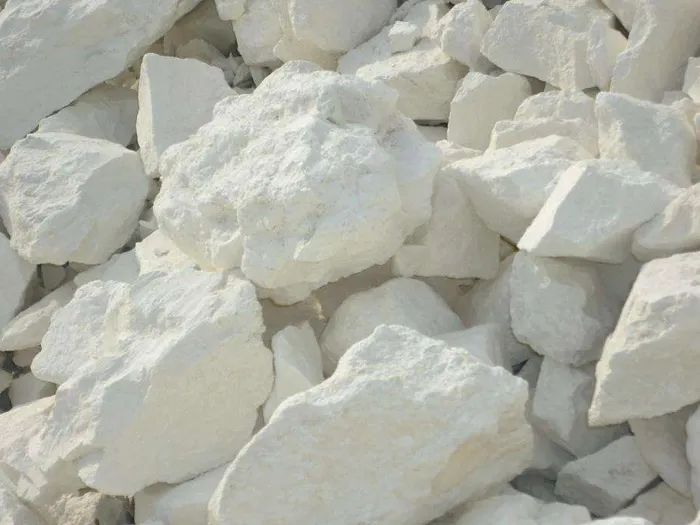Limestone is the main raw material for cement production. It takes about 1.4 to 1.5 tons of limestone to produce 1 ton of cement clinker. According to data from the National Bureau of Statistics, China’s cement production exceeded 2.3 billion tons in 2019, and the annual consumption of limestone exceeded 2.8 billion tons.
Moreover, central enterprises, state-owned enterprises, and large private enterprises dominate more than 80% of the cement industry. These entities control over 90% of the mining rights for limestone resources. As a result, more than 90% of limestone resources get used for low-value cement production, leading to significant waste.
So, in addition to producing cement, what other high-end applications does limestone have?

Producing calcium oxide
Calcium oxide, commonly known as quicklime, is obtained by high-temperature calcining of limestone. It comes in two forms: block and powdered. Based on calcium and magnesium content, it is categorized into industrial-grade and food-grade. Industrial-grade calcium oxide has four classes.
- Class I is for chemical synthesis.
- Class II is for calcium carbide.
- Class III is for plastics and rubber.
- Class IV is for flue gas desulfurization.
Calcium oxide is an important auxiliary material and basic raw material for steel and plastics. It has huge market prospects in environmental protection fields. Such as industrial wastewater treatment, garbage incineration, and flue gas desulfurization. As a cost-effective alkaline oxide, calcium oxide is also widely used in highways, high-speed railways, construction. Also in industry (non-ferrous metals, papermaking, sugar making, soda ash, food, medicine, building materials), agriculture, and other fields, making it an important basic raw material.
Production of calcium hydroxide
Calcium hydroxide is formed by the digestion of calcium oxide with water. The chemical formula is Ca(OH)2, commonly known as slaked lime. The aqueous solution is called clarified lime water.
Calcium hydroxide has the general properties of an alkali and is a strong alkali. Since the solubility of calcium hydroxide is much lower than that of sodium hydroxide and potassium hydroxide, its solution has relatively low corrosiveness and alkalinity.
Therefore, it can be used as an acidity regulator in food, serving functions such as buffering, neutralization, and solidification. Food-grade calcium hydroxide has relatively high activity, a loose structure, high purity, good whiteness, low impurity content, and does not contain harmful elements such as Pb and As.
Calcium hydroxide is widely used as a raw material in the calcium preparation production industry, with calcium gluconate being the most common product.
Calcium hydroxide can regulate acidity in milk powders and infant formulas. It can also serve as a buffer, neutralizer, and curing agent in beer, cheese, and cocoa products. Calcium hydroxide is used in making medicines and food additives. It adjusts pH and causes coagulation. For example, the synthesis of: high-tech biomaterials like HA, VC phosphates for feed additives, and calcium cyclohexane, calcium lactate, and calcium citrate.
Additionally, it is used as an additive in the sugar industry, water treatment, and other high-end organic chemicals. It is also helpful for preparing acidity regulators and calcium sources in edible meat semi-finished products, konjac products, beverage products, and medical enemas.
Development of calcium hydroxide
The calcium hydroxide industry in some countries developed earlier. The UK, the US, Germany, Japan, and South Korea all have an annual output exceeding 10 million tons. These countries mainly produce high-purity and high-whiteness products. Compared to them, the production capacity of China’s food-grade calcium hydroxide companies is less sufficient. High-grade products cannot meet international market demands due to technical limitations. Both the quantity and quality of products lag behind those of foreign companies.
Therefore, it is crucial to develop domestic calcium hydroxide enterprises from a high starting point and at a high speed. With the current technological advancements in the biological field in China, the application field of calcium hydroxide is becoming more extensive, especially with the huge demand for food-grade calcium hydroxide.
Production of nano calcium carbonate
Nano calcium carbonate refers to functional inorganic fillers with a particle size of 1-100nm, widely used in rubber, plastics, papermaking, ink, coatings, sealants and adhesives, medicine, toothpaste, food, and other fields.
The industrial production of nano calcium carbonate mainly relies on carbonization. The raw material is primarily limestone with a high calcium carbonate content. The production process involves calcination, digestion, carbonization, modification, dispersion, and drying to obtain the final powder material product.
For example, Shandong Donghua Technology Co., Ltd. processes limestone into high-end calcium-based new materials such as nano calcium carbonate. The price of lime ore, which is about 100 yuan/ton, can rise to 3,000 yuan/ton, and the price of food-grade nano calcium carbonate can reach 10,000 yuan/ton.

The current status of limestone resource mining and utilization in China
It is necessary to combine the specific conditions of current industrial development and product technology. So it can achieve high-value and efficient utilization of limestone resources. Furthermore, it is crucial to establish and subdivide the upper limit of limestone grade required for each product to maximize the value of high-grade limestone resources.
According to the gradient change of CaO content in limestone,
High-quality limestone with a content greater than 54% can produce high-value-added light calcium carbonate and nano calcium carbonate products. Industries that use these products include high-end plastics, papermaking, coatings, medicine, electronics, food, and others.
Intermediate-quality limestone with a content between 49% and 53% can produce active calcium oxide and calcium hydroxide. These materials find applications in metallurgical solvents, chemicals, and food deep processing industries.
Low-quality limestone with a content of less than 48% can produce the cement in construction industries.
By distributing limestone raw materials to various related industries according to their different calcium oxide content, a fully closed industrial chain can be achieved. This ensures high-quality resources, full utilization, and maximum value and environmental effects.